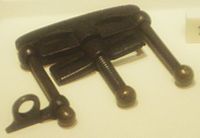This is an old revision of this page, as edited by 69.255.141.194 (talk) at 20:10, 30 August 2010. The present address (URL) is a permanent link to this revision, which may differ significantly from the current revision.
Revision as of 20:10, 30 August 2010 by 69.255.141.194 (talk)(diff) ← Previous revision | Latest revision (diff) | Newer revision → (diff)

The thumbscrews or pilliwinks is a torture instrument which was first used in medieval Europe. It is a simple vice, sometimes with protruding studs on the interior surfaces. The victim's thumbs or fingers were placed in the vice and slowly crushed. The thumbscrew was also applied to crush prisoners' toes. In an especially savage variant, the crushing bars were lined with carefully positioned spikes that punctured the nails and stimulated the incredibly sensitive flesh of the nail beds as the instrument was slowly tightened.
As late as the mid-18th Century, the ex-slave Olaudah Equiano testified to having witnessed the use of thumbscrews to torture slaves on a Virginia plantation (included in his autobiography "The Interesting Narrative of the Life of Olaudah Equiano").
Pilliwinks may also have been used to straighten girls' fingers in medieval and Renaissance England, similar to how braces are used to straighten teeth today. The pilliwinks used for this purpose probably differed from thumbscrews by squeezing the fingers. According to the Tudor historian Eric Ives, Anne Boleyn sent a pilliwinks to the nursemaid looking after her daughter, the future Elizabeth I.
Larger, heavier devices based on the same design principle were applied to crush knees and elbows.
External links
- http://www.angelfire.com/darkside/forgottendreams/thumbscrew.html
- http://www.dsl.ac.uk/dsl/getent4.php?plen=1544&startset=48903703&query=Pilli-&fhit=Win&dregion=form&dtext=dost
This torture-related article is a stub. You can help Misplaced Pages by expanding it. |